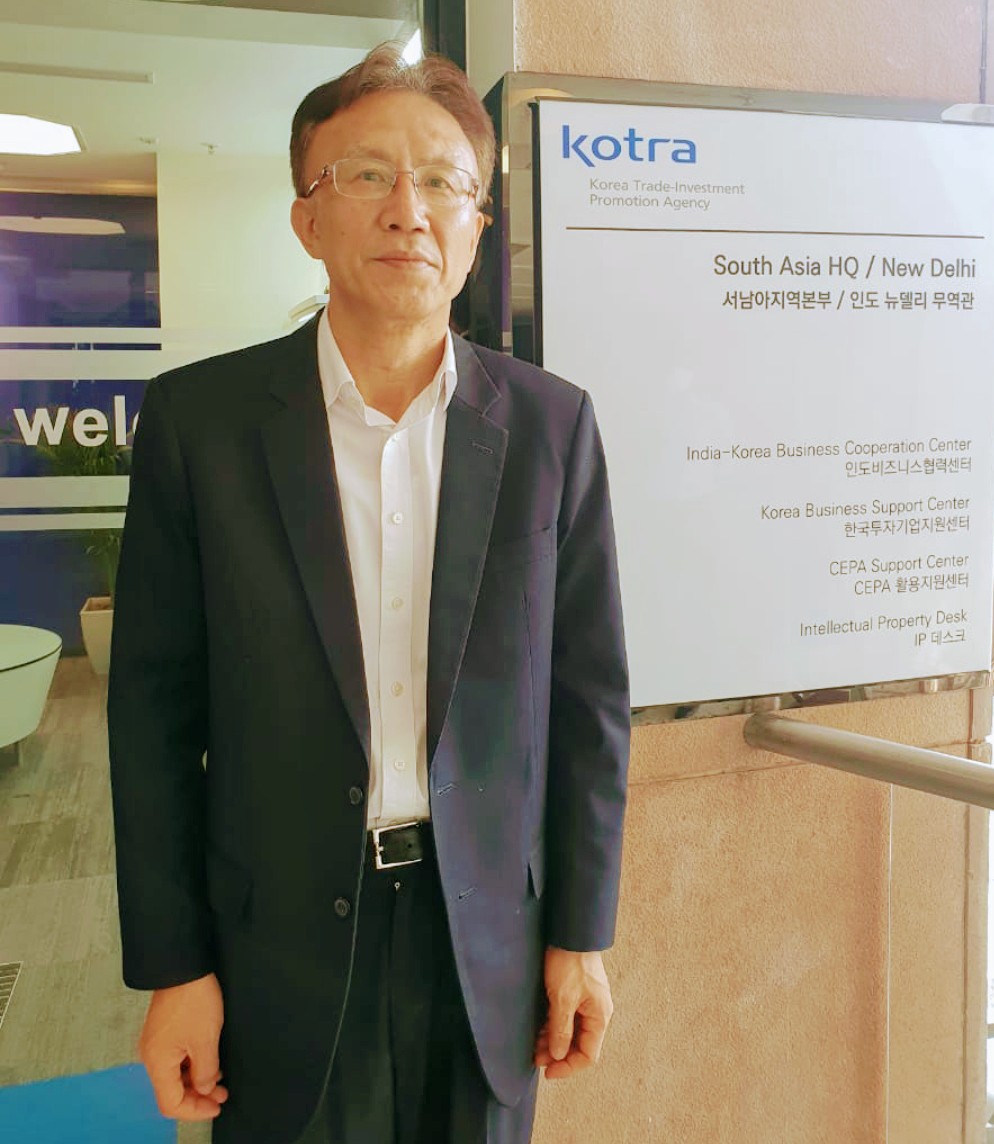Korean Honcho’s opinion: Indian Baniya community becomes world top 3 biz group, courtesy its 3,000-year old Karma tradition to lead India to G3 with PM Modi
KOTRA’s South Asia chief Kim Moon-young has written a book in the Korean language narrating how the Indian business community of Baniyas i.e. Marwaris, Gujaratis, Jains, Punjabis, others who have ruled the Indian corporate world. These Baniya merchant groups who are 2% (about 2.5 million) of the total Indian population, run currently 9 out of 10 top conglomerates in India. Book will boost the image of India among the Korean community in South Korea.
SUNDAY SPECIAL: Korean Book Review
New Delhi: If the year 2000 belonged to the rise of China as the world’s second-biggest economy after the US, Vietnam made its mark on the economic scene in 2010, the world in 2021 is all set to witness India becoming an economic superpower during the next decade.
A senior Korean executive has credited the Indian Baniya community and their 3000 years of Karma legacy for making India the potential world G3 superpower.
These Indian Baniya groups are and will remain dominant not only in traditional sectors but also in the new generation industries like IT-enabled e-commerce platforms and other services. Some of the examples are Reliance and Birla group of companies in the traditional sector, and Flipkart, Snapdeal, Infosys, and HCL in the modern era.

These observations have been made by Kim Moon-young (57), Managing Director, South Asia HQ, Korea Trade-Investment Promotion Agency (KOTRA) in his recently authored book “3000 년 ‘카르마‘가 낳은 인도상인 이야기” (An outcome of 3000 years of Karma legacy – an Indian Baniya story).
“The Indian Baniya community not only drove the economic prowess of India for over 3000 years, but they also continue to do it today, and will contribute in making India a world’s economic superpower in times to come as well. This community forms the part of the G3 merchant groups that include Jewish and Chinese merchant groups who own a major chunk of business activity across the world,” Kim said in an exclusive interview with Asian Community News (ACN) Network.
Printed and published in Korea, this 192-page book is a compilation of 34 fortnightly columns written by Kim Moon-young in well-known Korean newspapers like E-Daily (www.edaily.co.kr) during 2018-2021.
“Korean people should understand and know about the core competency of the Indian Baniya and NRIs to address and prosper with this huge and prosperous country
All the information he delivered is based on his first-hand exposure and practical experience while staying in Ahmadabad and North India.

The book is divided into three sections. The first section with 14 chapters talks about the Gujarati Baniya community and touches subjects like evolving India over 20 years, common characteristics between Indian and Jewish, Chinese and Korean merchants group, 3,000 year’s Baniya DNA, the emergence of Indian, Jewish, Marwari from the Thar Desert, Gujarat – the Indian Baniya Academy, Mr. Shah, One day of a Gujarati Jain Baniya, and others.
“Indian merchants from the Marwari community started their business from very tough terrains such as desserts in Rajasthan. They had chosen the path of the caravan business model and grew to become major financial partners of the Maharajas. So they know how to organize commercial business, not from any individual efforts but with the society approach like Jews and Chinese merchants who are well known for their collective approach.”
The book mentions how Marwaris have developed their own cooperation system and networks such as the lending of the seed money, operating of the “Vasa”, the modern version of Harvard Business School by providing free shelters and meals to their members. This kind of hostile surrounding made them competitive merchant groups in Rajasthan and Gujarat. The Guratat is also surrounded by a 1700kms coastal line, and they had to face tough weather. They also had to cross desserts in Gujarat, Rajasthan, and Sind area as trade between east and west flourished.
These Marwaris and Gujaratis had developed the habit of taking risks, and brave enough to overcome these difficulties. Whenever new chances came to this group, they could get the most benefit.
Indian Baniyas, part of the world’s top three merchant group:
“Gujarati merchants form the part of the world’s biggest G3 group of merchant communities that include Jewish all over the world and Chinese merchants who have overcome difficulties, coming from diaspora and suppression from the native societies.
The top G3 merchant community finds strong similarity of characteristics with Korea’s merchant community, Gaesung Merchants, originated from Gassung city which was then Korea Dynasty’s capital. Once the ruling group of this dynasty, they were forced to focus on trade and merchants after the new dynasty replaced them, and resultantly they developed their own credit and network system from the collective approach. Even these community groups contributed a lot to Korea’s development path since the 1960s.
The second section with 16 chapters is on the Indian economy and the third one with four chapters is about the India-South Korea commerce and trade relationship.
Book to change the negative image of India among Koreans:
“I have tried to approach with third party view with my affection for India and its people. Because there has been a distortion of facts about India in the Korean media and the many people in Korea think that India is a very mysterious country. It’s a country of yoga, music, caste systems, curry, and recent Indian Corona-19 Pandemic” said Kim.
 This book also touches India’s representative industries such as diamond, IT, Pharmaceutical, and vaccine along with License Raj, population, education, Modinomics and Self Reliant India, and FDI issues.
This book also touches India’s representative industries such as diamond, IT, Pharmaceutical, and vaccine along with License Raj, population, education, Modinomics and Self Reliant India, and FDI issues.
India in 2030 will be totally different in economic power and structure. Current India is different from what Kim experienced twenty years ago when he started his first overseas service at KOTRA New Delhi.
The author also suggests a very interesting perspective about the Indian Caste system in this book. It’s not a very special and unique system. Many other countries and societies have a similar system and Indian Caste culture is also changing as the economy is growing, the education of people is increasing, and also modernization and urbanization are changing the Indian caste system.
“But I suggest that the Indian caste system is not full of negative legacy and it has its own merit and special background. That’s why India Baniya reached the top level of the merchant group through over 3,000 years of tradition and transfer of merchant DNA. Every organization should have its own delegation of mission and have an intelligent group, governing group, the working group that is what history tells us. Indian system has kept its own merit. However, the caste system is not always good as it has its own incentives and hegemony as time goes on and exploitation of the upper class was institutionalized. Every country including India should find their balance point between functional and stratum class approach” Kim told Asian Community News (ACN) Network.
Author’s first-hand experience with Gujarati community:
Kim volunteered to go to India once again in 2018 after over 20 years of the time gap, not New Delhi, but Ahmedabad office which was to be opened as the 6th branch office of the KOTRA in India.
“As the sole Korean officer in Ahmedabad, I had to contact every level of the person from the base to the top line and I have had faced every mission and work from A to Z. As I had planned. Under these circumstances and through so much help and support, I could get invaluable opportunity and chances to meet, feel and think of India, Indian merchant (Baniya), and Indian people, not from the paper, but from my heart,” Kim added.
It was a great blessing for Kim to be able to meet so many Marwaris, other Gujaratis merchant groups who have dominated India for over 3,000 years and are still governing and will govern the Indian economy in the future. He said, “I was forced to contemplate on the root cause, reasons and characteristics of these Indian Baniya groups and have tried to understood why Indian Baniyas are among the world top 3 merchants groups along with Jewish and Chinese Merchants groups.”
Modi, the Indian Version of Deng Xiaoping, the architect of modern China:

Kim said he also tried to understand the new vision of Indian PM Narendra Modi who changed Gujarat from the grass-root stage to India’s manufacturing capital. It was the time of totally being fascinated by one great human being Modi.
“From my point of view, Indian PM and former Gujarat CM Modi is the Indian Version of Deng Xiaoping, the architect of modern China who had introduced a plethora of revolutionary economic reforms in the country in 1979 and made China what it is today.
Another 2 years in New Delhi as the Managing Director of KOTRA South Asia Head Quarter brought a more broad and balanced view about the past, present, and future of India and its economy.
About the author:

Moon-young Kim is currently the Managing Director of KOTRA, South Asia Head Quarter in New Delhi. KOTRA is the sole national trade and investment promotion agency of the Republic of Korea (ROK).
Born in Chungju City in 1963 in South Korea, Kim attained his initial education at Chungju High School and later went to at Seoul National University, Law College (BA), Brandeis University (Boston, US) to do MA (Economics), in International Economics and Development in 2005.
His professional career took off from KOTRA in 1992 when he joined its Asia Research Division. In 1998, he volunteered KOTRA New Delhi office and remained there till 2002 for five years.
He was at KOTRA New York Branch Office for the period 2006-2010. KOTRA Bangkok Office (2013-2016/Director), Ahmedabad Office (2018-2019/Director) with his overseas services.
Interestingly, Kim’s daughter designed the cover page of this book.
About price : KW 16,200(U$ 15) if ordered inside Korea through www.Yes24.com in other websites (but inside Korea delivery).




Interesting read
Wrong and poor analysis.
Probably you have seen a blog from India or some news article. Such articles never talk about population.
They only talk about numbers. Total number of billionaires, total number (XXX).
100 billionaires from 1 million people is far better achievement than 500 billionaires from 8 billion people.
Due to this, Jews are put above Whites in USA and not the other way around.
In India, there are 3 upper castes: Brahmins, Kshatriya and Baniya.
Hierarchically, Kshatriya caste has been ruling or warrior caste historically.
Baniyas has been the trading community.
While Brahmins had been scholars and teachers.
Due to Indian religion and considering teaching as more noble profession, Brahmins are put on top.
Most drum rolling or news thumping in India is about Brahmins and Baniyas.
In reality, Khatri community from Kshatriya caste rank 9x above Baniyas and 18x above Brahmins on:
#Unicorns/capita
#Billionaires/capita
In this blog, you will find link to population stats and number of unicorns held by each group:
https://casteindiadiscussions.blogspot.com/2022/12/which-group-in-india-is-most.html
Similarly, as per economic survey done in India. You will find:
https://www.india-seminar.com/2004/534/534%20sanjay%20kumar.htm
Khatri caste to be at top in India on socio-economic (per capita income) followed by Baniya followed by Brahmin.
Same applies for billionaires per capita which can be seen in this blog:
https://indianbillionairesbycaste.blogspot.com/2022/11/the-caste-of-indian-billionaires.html
Again, as I said.
There are 10x more Brahmins and Baniyas in India. Then there are Khatris.
So, most drum rolling and news coverage is about Brahmins and Baniyas.
Such articles never take or consider population into account.
Only talk about total number (XYZ).
Read the above links and you will figure out who is actually leading India.
Similarly,
Baniyas may be trailing Jews as of now.
Khatris (who are hierarchically upper caste than Baniyas (Brahmin > Kshatriya > Baniya)) are already ahead of Jews in business.
A short comparison:
Jews: Population: 14 million
68 Israeli immigrant unicorns in USA,
55 US unicorns (20% of native US unicorns),
92 in Israel.
Khatri caste: 2.8 million population
35 unicorns in India.
18 unicorns in USA
Per capita:
Jews: 15.35 unicorns/million
Khatri: 18.92 unicorns/million
As per the analysis of unicorn founders in India and USA by caste, we found that:
-> Brahmins run the highest number of unicorns in India and USA, followed by Baniyas and Khatri caste being the third most prominent group.
-> Out of 102 unicorns in India and 55 Indian unicorns in USA, 62 have a Brahmin co-founder, 59 have a Baniya co-founder while 53 have a Khatri co-founder.
-> On a per capita basis, the Khatri caste is at the top, followed by Baniya caste followed by Brahmin.
-> Punjabi Khatri make up 9% of Punjabi population in India (3.1 crore) which is 2.8 million.
-> Brahmin make up 4% of India’s population (5.6 crore or 56 million).
-> Agarwal, Gupta, Jain, Maheshwari and Gujarati Baniyas combined make up 1.72% of India’s population. Around 24.1 million.
1. BharatPe: Ashneer Grover
2. Zomato: Pankaj Chaddah
3. upGrad: Ravijot Chugh
4. MakeMyTrip: Deep Kalra
5. Nyka: Falguni Nayar
6. Zetwerk: Vishal Chaudhary
7. Ofbusiness: Ruchi Kalra
8. Sharechat: Ankush Sachdeva
9. Verse Innovations: Umang Bedi
10. Browserstack: Ritesh Arora
11. Mohalla Tech: Ankush Sachdeva
12. Dailyhunt: Umang Bedi
13. Unacademy: Gaurav Munjal
14. Cars24: Vikram Chopra
15. Postman: Ankit Sobti
16. Druva: Jaspreet Singh
17. Rivigo: Gazal Kalra
18. Delivery: Mohit Tandon
19. Billdesk: Ajay Kaushal
20. MPL: Shubham Malhotra, Shubh Malhotra
21. Coinswitch Kuber: Govind Soni
22. Mobikwik: Bipin Preet Singh
23. Acko: Varun Dua
24. Slice: Deepak Malhotra, Rajan Bajaj
25. Pristyn Care: Vaibhav Kapoor, Harsh Singh, Garima Sawhney
26. Mamaearth: Ghazal Alagh, Varun Alagh
27. LEAD School: Sumeet Mehta
28. Uniphore: Umesh Sachdeva
29. Oxyzo: Ruchi Kalra
30. Purplle: Manish Taneja
31. Shiprocket: Gautam Kapoor
32. Tata 1mg: Prashant Tandon
33. Shopclues: Sanjay Sethi
34. Rebel Foods: Jaydeep Barman
35. Innovaccer: Kamal Hasija
36. Laceworks: Sanjay Kalra, Vikram Kapoor
37. Netspoke: Sanjay Beri
38. Automation Anywhere: Neeti Mehta
39. Clubhouse: Rohan Seth
40. Commure: Hemant Taneja
41. Indigo AG: Rahul Bhatia
42. O9 solutions: Sanjeev S. Sidhu
43. Reltio: Manish Sood
44. Athelas: Tanay Tandon
45. Coda: Shishir Malhotra
46. Symphony: Romesh Wadhwani
47. Agent Sync: Niranjan Sabharwal
48. Seekout: Vikas Manocha
49. Axtria: Jaswinder Chadha, Navi Chadha
50. Minio: Garima Kapoor
51. Shipbob: Divey Gulati
52. Snorkel AI: Paroma Varma
53. Vise: Runik Mehrotra